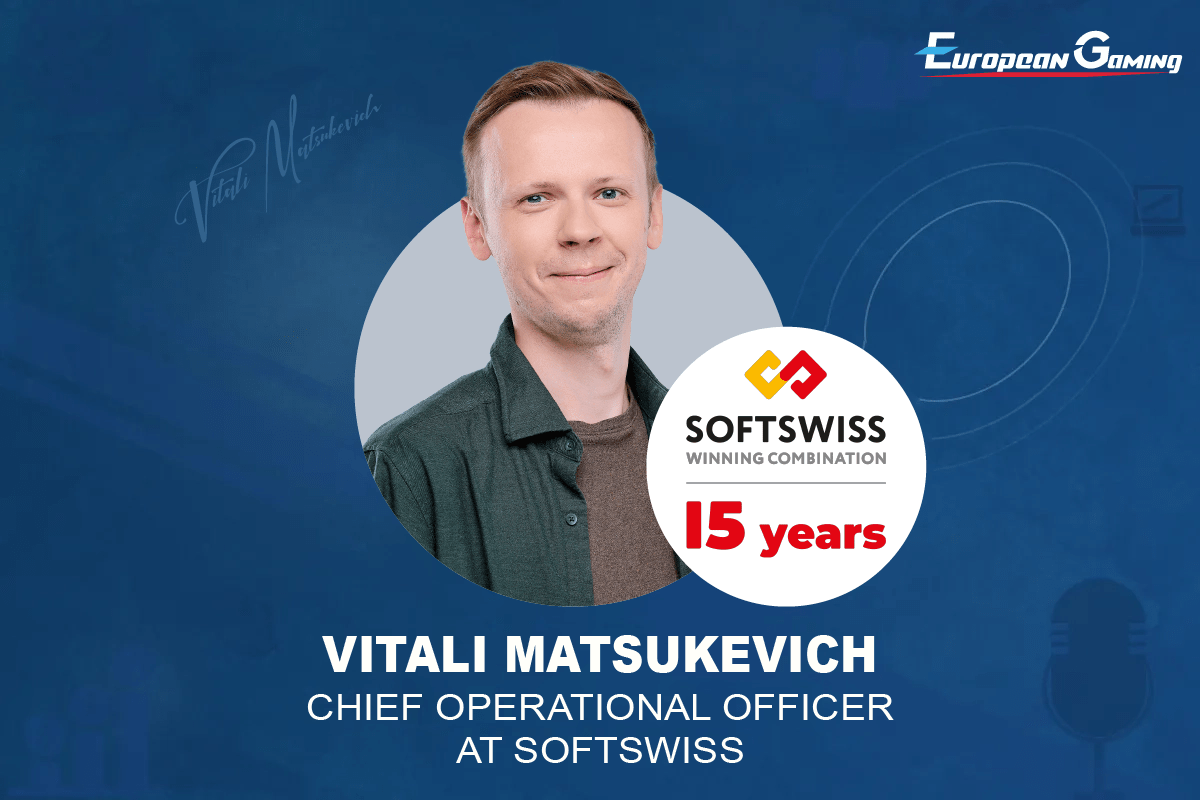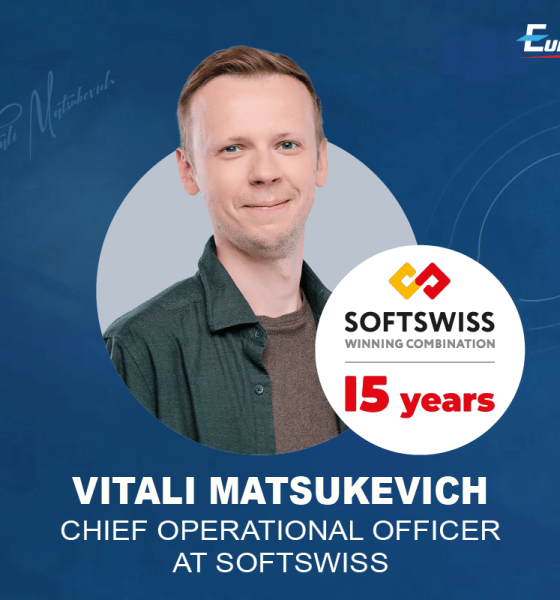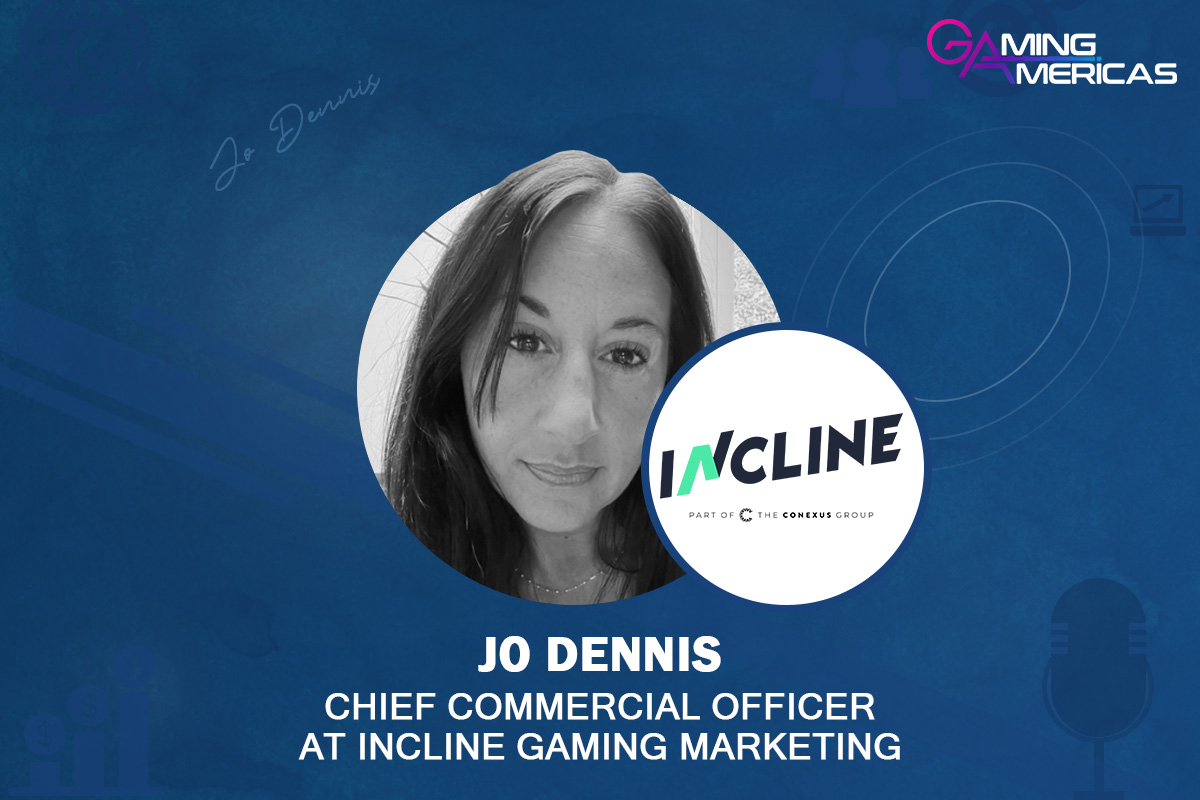

Interviews
Scaling Up in iGaming: Strategic Role of Platform Migration with SOFTSWISS
Platform migration has emerged as a critical strategy for operators looking to scale their operations, enter new markets, or address technical shortcomings. In an interview with European Gaming, Vitali Matsukevich, Chief Operational Officer at SOFTSWISS, delves into the intricacies of the migration process, the challenges operators face, and how SOFTSWISS has positioned itself as a leader in ensuring seamless transitions.
What drives operators to consider migrating from one platform to another? Could you explain the key issues they aim to resolve and why migration becomes necessary?
Vitali Matsukevich: The most popular reason is that the current platform no longer meets technical requirements, especially in terms of scalability and reliability. Operators often face issues like handling user loads they are currently experiencing or planning for. This often forces operators to seek a more stable and technically advanced solution to support their business growth. For example, in LatAm, we know of cases where operators face significant challenges due to downtime or unreliable operations. In some cases, this situation becomes unmanageable, and operators realise they need to migrate to a platform like ours, which offers 99.9% uptime and a seamless user experience.
Another reason for migration is the desire to expand to new geographies. For instance, if the current platform is not certified in a particular country, the operator may consider migrating to a platform that already has the necessary certification. While launching a new project on a different platform is an option, it can lead to operational challenges, such as managing two different projects on different platforms, which is not always convenient. In such cases, if the new market is attractive enough, it may be simpler to migrate to a platform that is already certified, obtain the necessary licence, and continue developing the project.
The third reason is dissatisfaction with the current software provider. This could be due to poor communication with business account managers, slow response times, lack of support, or the provider’s failure to implement client feedback. In the case of SOFTSWISS, we not only offer better service – as confirmed by various studies – but prioritise collaborative partnerships. Our partners highly appreciate our flexibility, openness to their suggestions, and commitment to developing the business together.
Moreover, operators who choose platforms used by major industry players benefit from being part of a community and gain access to features requested by those larger brands. For example, when large operators asked for specific product updates, we later rolled them out to all clients, which received positive feedback. We also have a well-structured workflow for managing client requests, where we gather all ideas, suggestions, and comments from our partners, and our product team evaluates which of them will have the most impact.
What specific technical and operational advantages does the SOFTSWISS platform offer to operators who decide to migrate?
Vitali Matsukevich: I would highlight two key advantages: the high technical performance of our platform and the well-established interaction with our partners. Because our partners don’t experience technical difficulties, they can scale their projects without worrying about the technical aspects of their business. Our recent migration case, where we transitioned over a million players to our casino platform and sportsbook within five hours, further confirmed the high technical level of our solution and well-defined migration process.
A unique feature of migration is that after reopening a project post-update, there’s often a surge in user activity, with more people visiting the platform than usual. This contrasts with the gradual user growth seen when launching a new project, where users join the platform over time.
After migration, a large number of users might access the platform simultaneously. To prepare for this, we conducted numerous stress tests before the launch and executed the migration flawlessly. The number of issue reports was even lower than we expected.
What are the main challenges operators may face during migration, and how does SOFTSWISS help minimise these risks?
Vitali Matsukevich: The main challenge is the inevitable player churn. Before the transition, operators conduct extensive information campaigns about technical changes and migration to a new platform, but not all users take the necessary actions to transfer their accounts. On our side, we assist in communication, share experiences from previous migrations, and make the process as easy as possible for users.
Another challenge is that users might notice differences between the two platforms. For example, even if both platforms offer the same types of bonuses, they might be implemented differently or might have other slight differences. In this case, we strive to visually adapt the new platform to resemble the previous software. We also transfer all possible and significant information about players’ gaming preferences, for example.
Overall, this is a complex process. We need to assess which aspects of the previous user experience should be transferred to the new platform. Sometimes, it may also be decided to enhance certain features.
Another important challenge is maintaining SEO rankings so that the project continues to receive stable traffic from this channel. Our experienced specialists help transfer all necessary information, adapt pages, and take other actions to ensure that search engines either don’t notice the difference or even improve the project’s search ranking.
What steps are taken to minimise player churn and ensure their loyalty after migrating to the new platform?
Vitali Matsukevich: An individual strategy is developed for each project and specific user groups. This can include additional email campaigns offering players bonuses or other unique personalised offers during the transition period. This approach helps retain users and makes the migration process as attractive and seamless as possible for them.
What metrics do you use to evaluate the migration success, and how do you measure its impact on the operator’s business?
Vitali Matsukevich: The key metrics we use to evaluate the migration success include the speed, downtime, player retention rate (how many users successfully transitioned to the new platform), and the load on customer support. These metrics allow us to objectively assess how smoothly the migration went and identify any areas that may need improvement in future migrations.
What are SOFTSWISS’ plans for further developing and improving the migration process?
Vitali Matsukevich: After each migration, we refine our current workflow, adding new elements based on the experience gained. We are also actively working on obtaining additional certifications, as we are currently doing in Brazil so that our partners can quickly and seamlessly launch their projects as soon as they have the necessary licence.
How does operator feedback play a role in improving the migration process, and how does SOFTSWISS incorporate their suggestions and feedback?
Vitali Matsukevich: We actively gather feedback from our partners and conduct retrospective discussions within our team. During these meetings, we analyse the metrics and identify any delays or issues. It’s important to note that each migration is a unique project, and while the core steps remain the same, the workflow is always adapted to the specific case. This approach allows us to continuously improve our migration process and ensure successful collaboration with our partners.
Can you provide examples of successful migrations where your approach led to significant improvements for the operator?
Vitali Matsukevich: Yes, one of the most compelling examples of a successful migration is when we transitioned over a million players from a competitor’s platform to the SOFTSWISS Casino Platform and the SOFTSWISS Sportsbook in just five hours. This migration was a significant achievement, showcasing our platform’s technical robustness and our team’s ability to manage complex, large-scale transitions with minimal downtime.
During this process, we meticulously planned and executed the migration to ensure that player accounts, balances, and gaming histories were seamlessly transferred without any data loss.
The post Scaling Up in iGaming: Strategic Role of Platform Migration with SOFTSWISS appeared first on European Gaming Industry News.
Conferences in Europe
Strategies that Scale: Evoplay’s Alex Malchenko on Cracking the Code of Localised iGaming Success

Alex Malchenko, Head of Sales at Evoplay, joins us for an exclusive conversation ahead of HIPTHER’s European Gaming Congress 2025.
Evoplay, proud Pen & Paper Sponsor of this landmark event, continues to pave the way in iGaming with pioneering content, creative game design, and strategic market expansion.
With over a decade of B2B sales experience, Alex has played a lead role in entering regulated territories, forging new Bingo and Lottery partnerships, and launching fresh business directions – making him the ideal voice to explore insights around localising content for different markets: challenges, nuances, and successful strategies.
Alex, with your background scaling new markets and products, what challenges have you encountered with content localisation in the iGaming space?
When we enter or grow in a new market, we look at its own specifics. In some markets, the main challenge is regulation, whether it’s strict certification rules, requirements on game content and promotions, RTP levels, or even small details like how session time is displayed. That’s why we take time to understand the rules, the culture, and what local players actually want.
One good example is our instant game Penalty Shoot-Out: Street, which we created for Brazil and its strong football culture. The challenges there were both technical and regulatory, since Latin American markets often have very different rules. In some countries, just certifying the game isn’t enough — additional RGS and RNG certificates and official confirmations are also required.
On top of that, we had to make sure the gameplay matched what players expected. With Penalty Shoot-Out: Street, we achieved this by combining fast bets, quick results, a familiar theme and the thrill of every goal, and it worked.
Another case is our Hot Triple Sevens, a worldwide-popular slot, which we’ve refreshed with new mechanics like Hold & Win. Then we re-skinned the game to suit different audiences — for example, American Sevens and Fogo do Brasil 777 — to make them resonate more with local styles and tastes.
When games are built with the right themes and mechanics for a specific market, they feel more engaging and relevant to players, which can significantly boost their appeal. That’s why localisation is something we put thought into every time, learning from experience, working with partners, testing locally and improving as we go.
When it comes to Evoplay approaching localisation for a new market, what are the first strategic frameworks or priorities you put in place?
In short: regulation, communication with partners, and understanding players. When entering a new market, we carefully study all aspects, analyse the situation, and build a strategy. This includes legal, commercial, marketing and financial components, among others. Of course, for a complete picture, we also look at competitors’ experience, talk extensively with local participants, and study players — sometimes launching special campaigns independently, sometimes in collaboration with partners.
In this regard, Evoplay has made significant progress this year, reaching a new level. To support this approach, we also run campaigns that help us better understand players and their preferences. For example, the Oath of Steel campaign with SlotsCalendar, featuring a shared prize pool, invited players to take part and share their feedback, which we looked at thoughtfully. Similarly, we worked on a joint game with SlotCatalog, drawing on insights from their player preference analytics. Initiatives like this give us a better sense of what players enjoy and help us shape our games for different audiences, supporting our broader approach when entering or growing in new markets.
Could you share an example where you had to adapt a game significantly – theme, mechanics, or language – to resonate with local players? What were the specific market nuances you had to tune into?
In our business, every game must meet regulatory requirements, and it’s normal that adapting a game for a specific market requires some extra adjustments. A good example of this is the lottery vertical, which is quite different from standard iGaming. In our business, every game must meet regulatory requirements, and it’s normal that adapting a game for a specific market requires some extra adjustments. A good example of this is the lottery vertical, which is quite different from iGaming. Here, we need to follow particular rules regarding content and promotions, along with other market-specific restrictions.
Other bright examples of our games adapted to local markets include mythology-inspired hits like Temple of Thunder II Bonus Buy and Roman Rule, as well as the previously mentioned American Sevens and Penalty Shoot-Out: Street. These games work well because everything comes together — the theme clicks with players, the visuals fit the concept, and the mechanics are engaging. I’d also highlight the simplicity of the games and their user-friendly UX/UI, which players appreciate no matter the region.
Operating in regulated markets obviously adds complexity. How do you strike the balance between compliance (e.g., legal, cultural mandates) and maintaining the brand’s creative integrity during localisation?
In situations like this, branded games are a good approach. Creating them involves working closely with partners, discussing details such as logos and technical settings like RTP or bet ranges.
At the same time, we like to experiment with small creative touches to see what really clicks with players. A good example is The Easter Catch slot, an updated version of our worldwide popular The Greatest Catch, especially designed for the Easter holidays. Taking this approach keeps the game flexible, meets legal and cultural requirements, and still feels like our brand. Tailoring it for the partner and their audience also makes the game more engaging and usually leads to better performance.
You’ve been instrumental in forging Bingo and Lottery partnerships. How does localisation differ when tailoring for those verticals versus standard casino-style titles?
First of all, I want to emphasise that Bingo and Lottery are quite different from standard iGaming. These are established verticals with their own history, unique communities, and regulatory features. The lottery market is also largely monopolised and moves at a slower pace compared to the fast-moving world of iGaming.
Some online lotteries, while offering more dynamic and engaging experiences than paper versions or traditional online formats, are subject to many restrictions. For example, design themes common in slots are often prohibited, RTP requirements differ, and other regulatory rules apply.
When it comes to trends in this area, the World Lottery Association sets the pace, and other lotteries tend to follow their lead.
Evoplay entered this sector to bring a fresh, innovative perspective, showing how classic games can be reimagined for a new generation of players and enthusiasts seeking new experiences. The projects we’re currently developing here hold great promise and add a fresh spark to this traditional space.
Thank you, Alex, for walking us through Evoplay’s thoughtful approach to content localisation and the art of balancing strategy with respect for local flavor. We can’t wait to hear more from you and other industry leaders live at the European Gaming Congress 2025.
Join us at the European Gaming Congress 2025 | 30–31 October | Warsaw
The post Strategies that Scale: Evoplay’s Alex Malchenko on Cracking the Code of Localised iGaming Success appeared first on European Gaming Industry News.
Interviews
HIPTHER Community Voices: Alieu Kamara – Founder and CTO of AmaraTech

You’re the Founder and CTO of AmaraTech—what inspired you to start the company, and how has your journey shaped where you are today?
Our Story: Technology Innovation Born from Purpose:
AmaraTech IT Solutions, founded in 2020 in the Washington, DC metro area and expanding strategically into Africa, dedicated to transforming communities through technology. Our journey began with a profound experience in Liberia, a country riddled by 14 years of brutal civil war, witnessed the limitations on human potential and economic growth due to inadequate technology infrastructure. This experience sparked a deep commitment to making advanced technology accessible for all, enabling organizations to flourish amid challenges. We truly believe in technology’s amazing ability to empower and transform communities everywhere.
Intro Link: https://www.youtube.com/watch?v=wstteIwaSKk
What’s one big lesson you’ve learned as a founder that you wish you knew earlier?
Learning to say no as a founder is one of the most critical yet counterintuitive skills for startup success. The natural instinct is to say yes to every opportunity, partnership, feature request, and meetings, but this creates resource dilution, product confusion, and team fatigue that ultimately kills focus and progress. Startups with limited time, money, and energy must recognize that every “yes” is an implicit “no” to something else, and that niche dominance beats broad mediocrity. The cost of learning this lesson late includes providing so many products that confuse users, burning resources on low-impact initiatives, and missing opportunities in core focus areas. Successful founders develop “hell yes” criteria, create decision frameworks, practice graceful declines, and conduct regular priority audits to maintain laser focus. The paradox is powerful: saying no to more opportunities allows you to say a much bigger yes to what truly matters, creating clearer product vision, stronger team alignment, better resource utilization, and ultimately more fundable and successful business.
In your view, what makes great managed services today—and how do you bring that to life in the work you do?
At AmaraTech, we believe great managed services today go far beyond traditional IT support—they require proactive, AI-driven cybersecurity intelligence tool that prevents threats before they impact business operations. We deliver this through our integrated ecosystem approach, where cutting-edge threat detection, cloud infrastructure, and business applications work seamlessly together under 24/7 SOC monitoring. What sets AmaraTech apart is our commitment to being true strategic partners: we develop deep industry expertise to understand each client’s unique compliance requirements and operational challenges, then translate our technical capabilities into measurable business outcomes like revenue protection and competitive advantage.
Through transparent reporting, continuous innovation with leading cybersecurity vendors, and flexible engagement models that scale with growth, we don’t just manage technology—we architect security-first solutions that drive business success. When you partner with AmaraTech, you’re not getting a vendor; you’re gaining a cybersecurity-focused technology advisor dedicated to keeping your business protected, compliant, and positioned for innovation in an increasingly complex threat landscape. My passion for helping organizations embrace progressive technology drives successful business transformation and seamless technology integration, positioning our company as a leader in next-generation cybersecurity solutions.
Do you see any gaps in the tech industry that you think more companies should be addressing?
The cybersecurity industry urgently needs to develop AI-native security frameworks that can match the speed and sophistication of AI-powered attacks, which are scaling exponentially while traditional defenses remain linear. Current cybersecurity frameworks are built on reactive, signature-based models that cannot adapt fast enough to counter AI-generated attack variations, creating dangerous gaps in real-time threat response.
The industry must prioritize developing adaptive security architectures that integrate human expertise with AI-driven defense systems, democratize advanced security tools for organizations of all sizes, and establish rapid threat intelligence sharing networks that operate at machine speed. At AmaraTech, we’re addressing these framework gaps by building AI-enhanced security operations that evolve with threat patterns, making enterprise-grade adaptive defenses accessible through managed services, and creating collaborative intelligence systems that amplify human analyst capabilities rather than replacing them. The critical challenge is shifting from traditional periodic security updates to continuous, proactive AI-native frameworks that can defend against tomorrow’s threats today—because the window for reactive cybersecurity approaches is rapidly closing in an AI-accelerated threat landscape.
How do you keep up with the fast-changing tech landscape—especially when it comes to things like cybersecurity, compliance, or AI?
As cybersecurity threats evolve at unprecedented speed with AI-powered attacks and constantly shifting compliance requirements, AmaraTech maintains its competitive edge through a comprehensive intelligence ecosystem that combines strategic vendor partnerships, real-time threat monitoring through our Security Operations, and active participation in threat intelligence sharing communities. Our team maintains cutting-edge certifications while operating hands-on testing labs for emerging AI security technologies, ensuring we can rapidly assess, deploy, and scale new defensive measures across our client portfolio within hours of threat emergence. This systematic approach to continuous learning—from regulatory compliance partnerships to client-driven insights and internal knowledge sharing—positions us as a proactive cybersecurity advisor who anticipates and prepares for threats before they impact business operations. While many MSPs react to security incidents, our commitment to staying ahead of the threat landscape through multi-layered intelligence gathering and rapid adaptation capabilities ensures our clients receive protection against both current attacks and tomorrow’s emerging cyber challenges, making cybersecurity readiness a competitive advantage rather than a reactive necessity. It enables organizations to thrive in our increasingly connected, threat-aware digital landscape by fostering inclusive partnerships that bridge technology gaps and accelerate innovation adoption across diverse business sectors.
What’s coming up next for you and AmaraTech—any big plans, goals, or ideas you’re excited to roll out?
I’m currently leading the development of a groundbreaking AI-powered cybersecurity platform designed to revolutionize security management for businesses and organizations through advanced technology integration and intelligent automation. This comprehensive solution leverages custom AI models built on cutting-edge large language models to enhance user interaction and automate complex security workflows, delivering protection through a dual-module architecture. The platform combines systematic Vulnerability Management—featuring automated assessment, structured remediation workflows, and continuous monitoring capabilities—with advanced Threat Intelligence that generates operation-specific insights tailored to each organization’s unique risk profile, industry sector, and business context. By delivering actionable threat intelligence for informed risk assessment and strategic remediation planning, this innovation empowers organizations to systematically identify, prioritize, and address security risks while maintaining regulatory compliance, ultimately improving overall security posture and delivering personalized cybersecurity experiences that create measurable business value across diverse client platforms.
The post HIPTHER Community Voices: Alieu Kamara – Founder and CTO of AmaraTech appeared first on European Gaming Industry News.
bespoke solutions
The White Label Dilemma: Finding the Right Balance for Your iGaming Business

It’s not just black and white label
Yoni Sidi, CEO at Wiztech, says white labels are all about striking the balance between pros and cons, but for some, it’s impossible to achieve and that’s why it’s important to consider other options.
For most operators, a white label solution seems to offer the best route to market. But is that actually the case?
I’ve been working in the industry for more than two decades now, and over that time, I’ve worked on both sides of the fence – so on the white label operator side and on the white label provider side. This gives me a deep understanding of the pros and cons of white label solutions, and this understanding ultimately led me to launch Wiztech. To answer your question more directly, white labels are always about striking the balance between the pros and cons they present – for some operators, a balance can be found, but for others, it can’t. Ultimately, it comes down to knowing what you want from your platform or technology stack, and whether a white label can meet those requirements with the budget and resources you have available to you.
So, what are the pros and cons of a white label platform?
There are plenty of upsides to white labels, and that’s why they’re used by so many operators. The main advantages are speed to market and cost effectiveness – you can literally go from first discussions to your online casino being live in a matter of weeks. The upfront fees are relatively small, and, in most cases, you pay a revenue share back to the platform provider. This can tighten margins a little, but it means you don’t have to have a large capital reserve to get going. Another benefit is that you can take on as much or as little of the operation as you like – for some, they will let the platform provider take care of the operational aspect while they focus solely on marketing and customer acquisition. Other upsides include licensing, with the white label partner securing and being responsible for the licences they hold.
Drawbacks. The biggest for me is the lack of differentiation you get with a white label. The many brands that run on the platform often look very much the same, just with different logos and branding. After a few months of operating your online casino, you’ll likely notice friction points that you’ll want to address, but the rigid nature of white-label platforms means it’s incredibly difficult to smooth out even the smallest of bumps in the road. It’s also incredibly difficult to roll out unique features and functionality as the development team is usually working through a backlog of requests – most of which are for the friction bumps that need ironing out. Factor in the frequent regulatory changes that happen, and the need for the development team to respond to them, and it’s easy to see how hard it can be to improve the experience being offered to players.
How can operators strike a balance between the pros and cons of white labels?
It comes down to understanding the capabilities of the platform provider and whether they offer customisation and localisation. If they don’t, the operator needs to determine if this is a price they’re willing to pay in exchange for the speed to market and cost effectiveness that white labels provide. Of course, some white label providers do offer support and are happy to help when it comes to developing and deploying bespoke features and functionality. But in my experience, most don’t have the capacity for this, even if they say they do. For me, the balance is found by accepting the limitations of white labels and working within the (often pretty rigid framework) they provide. There are plenty of examples of operators that have done this and have gone on to run very successful brands in highly competitive markets.
Is there an alternative to white labels?
The most obvious alternative is to develop a proprietary technology stack, but this approach comes with just as many, if not more, pitfalls. Building a platform from the ground up is incredibly expensive and tremendously risky, and this is why so few operators outside of the industry power players have been able to pull it off. And even those that do often encounter issues such as ongoing maintenance, tech debt, staffing and compliance. But there is a middle ground between white label and proprietary, and it can be found with smaller platform providers whose technologies offer the agility, flexibility and adaptability required for operators to launch highly customised, almost bespoke, online casinos and sportsbooks.
How does Wiztech fit into the platform mix, and how do you support your partners in achieving their goals in often highly competitive markets?
At Wiztech, we champion modular tech and the likes of AI and automation. By embracing these, we have been able to build powerful yet highly customisable casino and sportsbook solutions that are also fully compliant in tightly regulated markets. In our experience, being able to quickly respond to regulatory changes provides a competitive advantage to our customers. In Mexico, for example, our client Winpot has been able to deliver a unique player experience while always ensuring compliance. And this is against a backdrop where regulatory changes often come with very little notice. Our technology can adapt quickly while Winpot continues to capitalise on the growing demand for entertaining online casino products and experiences.
But just as important as our technology is our approach to our partners. This sees us undertake a comprehensive onboarding process where we spend a lot of time understanding the client’s “why” before we map out the “what” and the “how”. This has proved to be incredibly effective and ensures that our clients can get the most out of the flexibility of our platform and the high levels of customisation and personalisation it provides.
The post The White Label Dilemma: Finding the Right Balance for Your iGaming Business appeared first on Gaming and Gambling Industry in the Americas.
-

 gaming3 years ago
gaming3 years agoODIN by 4Players: Immersive, state-of-the-art in-game audio launches into the next generation of gaming
-
EEG iGaming Directory9 years ago
iSoftBet continues to grow with new release Forest Mania
-
News8 years ago
Softbroke collaborates with Asia Live Tech for the expansion of the service line in the igaming market
-
News7 years ago
Super Bowl LIII: NFL Fans Can Bet on the #1 Sportsbook Review Site Betting-Super-Bowl.com, Providing Free Unbiased and Trusted News, Picks and Predictions
-
iGaming Industry8 years ago
Rick Meitzler appointed to the Indian Gaming Magazine Advisory Board for 2018
-
News7 years ago
REVEALED: Top eSports players set to earn $3.2 million in 2019
-
iGaming Industry8 years ago
French Senator raises Loot Boxes to France’s Gambling Regulator
-
News7 years ago
Exclusive Interview with Miklos Handa (Founder of the email marketing solutions, “MailMike.net”), speaker at Vienna International Gaming Expo 2018













